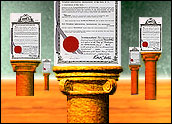
Patents can be one of the most lucrative pieces of intellectual property a company can own, particularlyfor any business in the technology sector. However, they are also one of the most costly and expensiveforms of intellectual property available. For complicated patents, the application process can runupwards of US$10,000, filing fees can be upwards of $3,000 per country, and regular maintenance fees willcost hundreds of dollars a year over the life of the patent.
This mean not only that you should considerthe value a patent will bring to your business, but also where toregister it to be most effective and cost-efficient in protecting your rights nationally andinternationally.
Following is a general overview of important considerations for anytechnology company. A patent agent or patent lawyer will be able to guide you through the complicatedbut lucrative process for your particular needs.
Where to File?
The most important jurisdictions for patent protection of an invention are the ones wherein itis manufactured and sold. For smaller companies, this will often be the same country. For largercompanies, and companies that take advantage of foreign labor, filing patents in all those countrieswill need to be considered.
Manufacturing-heavy jurisdictions like China, Taiwan, Japan and Indiaare important jurisdictions to hold a patent to ensure that competitors do not begin competingmanufacturing businesses, creating competition when you would otherwise be granted a monopoly.
For technology-based businesses, casting a wider net of patent protections is preferable. Technologymanufacturing can be readily copied overseas, and the universality and portability of technology-basedinventions means there’s an easily accessible global market for any would-be patent infringer.
Moreover, particular consideration should be given to your business partners. Modern technology oftenrelies on the use of dozens — if not hundreds — of patents interplaying in a single device. Having a patentwhere both your partners and competitors reside will give your company the means to remaininvolved in the manufacturing process, while enabling tidy licensing fees to quickly accrue.
No ‘International’ Patent
Though larger companies will seek to obtain an “internationally” recognized patent, in actuality, allpatent applications must be filed on a national basis. Attempting to coordinate, file, and respond to awide variety of jurisdictions would be time-consuming and near-impossible if businesses had to treateach and every patent application as if it were from scratch.
Fortunately, the internationally recognizedPatent Cooperation Treaty has attempted to streamline the process. In addition to giving each countrya more-standardized application that will be applicable in all member countries, the Patent CooperationTreaty also provides an inventor with an additional 30 months to determine which countries the patentwill actually be filed with.
This additional time allows inventors to not only determine which jurisdictionswill be most useful, considering their manufacturing and demographic needs, but also allows inventorssubstantially more time to raise the funds necessary to pay for the relatively expensive applicationprocess.
Minimize Cost, Maximize Protection
Whether an inventor proceeds under the Patent Cooperation Treaty or not, each country will still havethe final say on whether the patent can be issued in that country. If an inventor is looking only for oneor two countries — say, Canada and the United States — proceeding under the Patent Cooperation Treatywill likely be an unnecessary expense. Though the removal of the international application process doesdramatically reduce the fees associated with a patent application, the costs can still be significant.
Ultimately, the decision of where to file a patent is not to be taken lightly. Even for a large multinationalcorporation, a truly worldwide patent filed in every possible country would be cost-prohibitive. However,filing in too few jurisdictions may result in a competitor operating free and clear to huge markets inother parts of the world.
Ultimately, the decision is a business one, as spending fees obtaining a patentwhere your product never sees the light of day can be as disadvantageous as not seeking a patent inthat country at all.
For startup technology companies, the initial investment can often be seen as a daunting and cost-prohibitive expense. However, with careful consideration of your business needs, and assistance froma lawyer or patent attorney, the cost can be effectively minimized while maximizing the protection andprofitability a multinational patent can provide. Having a patent lawyer or patent agent can greatly aidyour company in obtaining the necessary intellectual property in a cost-effective manner.



































Social Media
See all Social Media